Comprehensive Report: Challenges and HR Practices at Tesco
VerifiedAdded on 2020/07/23
|9
|2341
|61
Report
AI Summary
This report analyzes the challenges Tesco faces in effectively managing its workforce, focusing on issues such as employee behavior, productivity, and the impact of internal and external factors on HR practices. The report examines contemporary management challenges, including the need for skilled recruitment, adapting to global market changes, and fostering employee loyalty. It highlights the importance of technology and diversification in HRM, as well as the influence of organizational structure, economic shifts, technological advancements, and competitor actions. The conclusion emphasizes the need to overcome these challenges by recruiting the right personnel, providing employee support, and implementing training programs to enhance skills and adapt to technological changes, ultimately aiming to improve production and enhance the company's reputation.
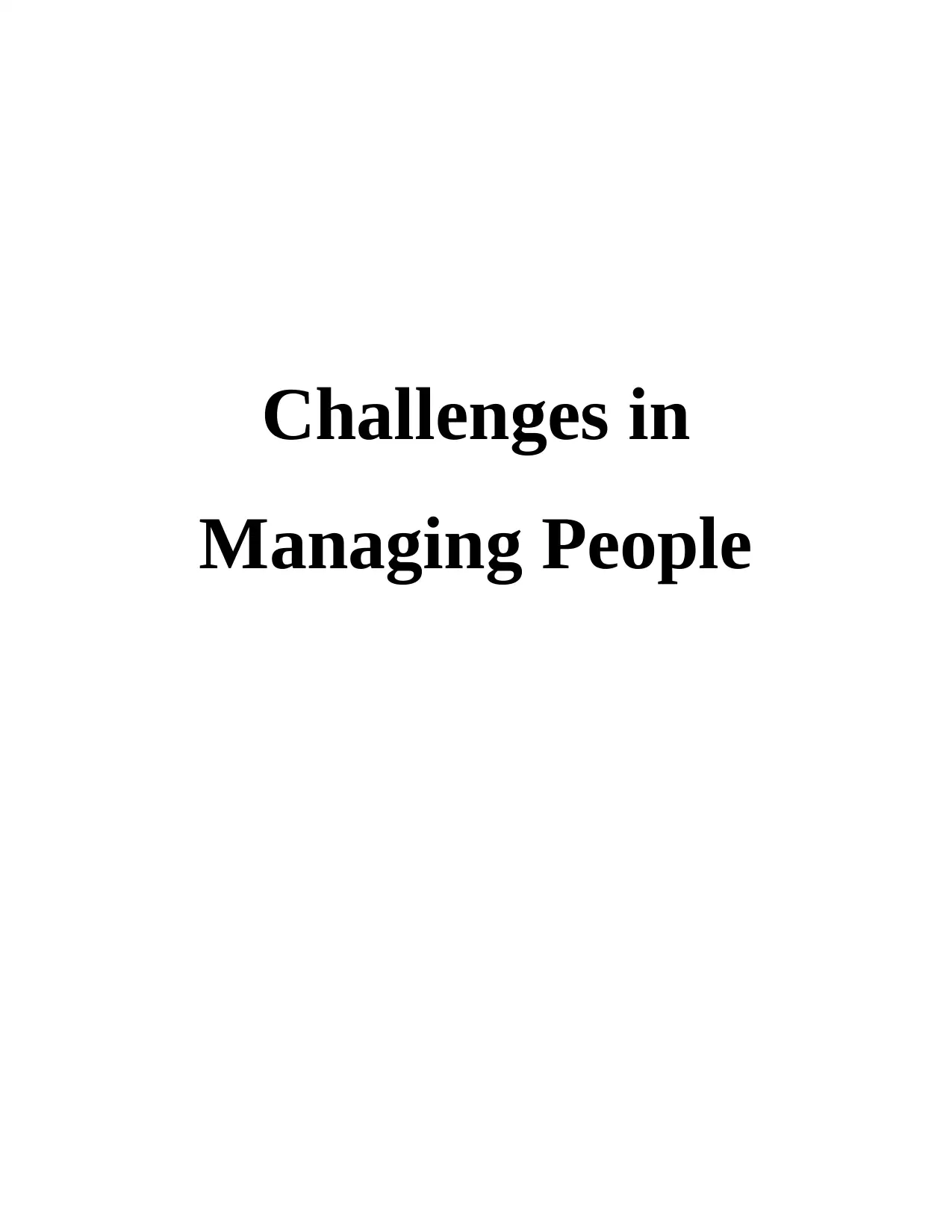
Challenges in
Managing People
Managing People
Paraphrase This Document
Need a fresh take? Get an instant paraphrase of this document with our AI Paraphraser
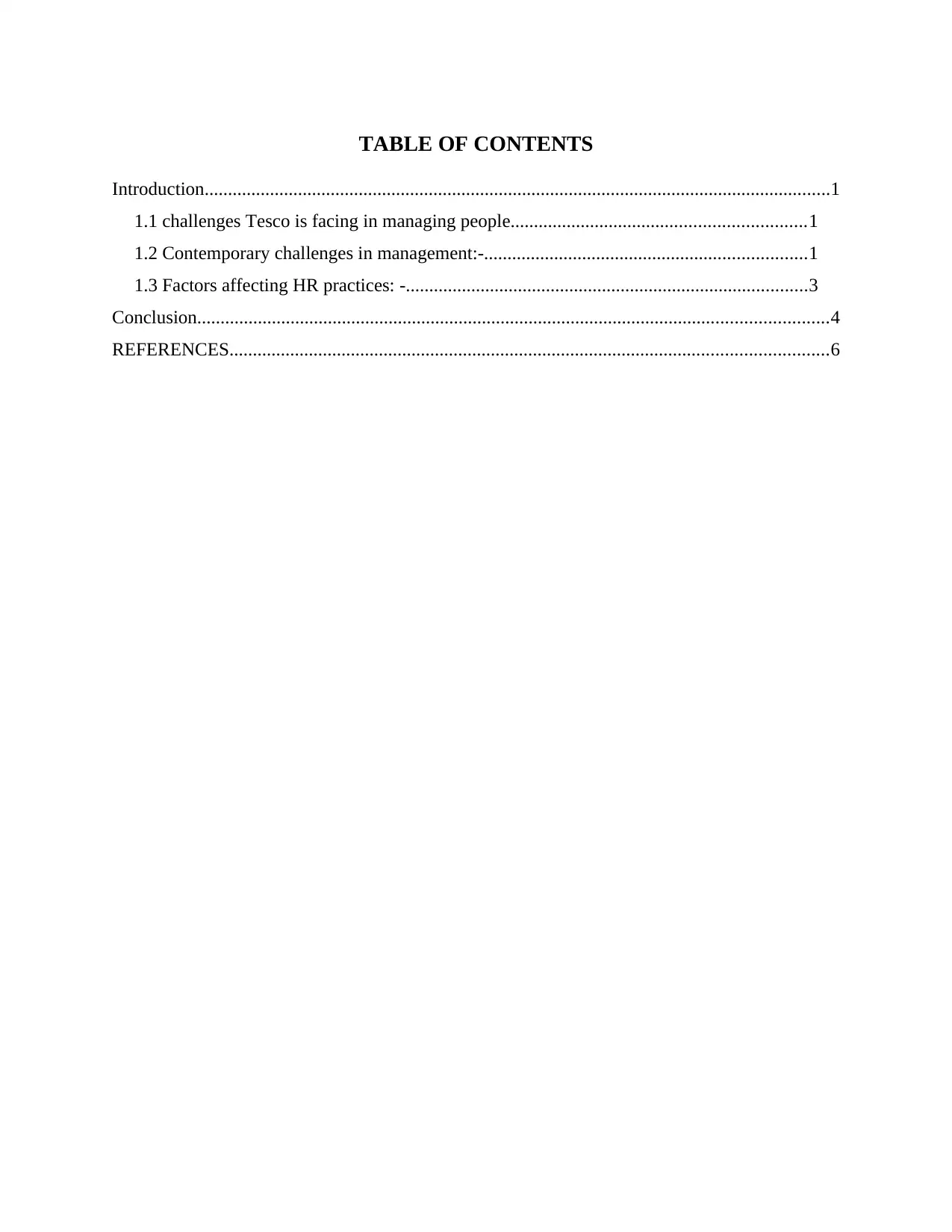
TABLE OF CONTENTS
Introduction......................................................................................................................................1
1.1 challenges Tesco is facing in managing people...............................................................1
1.2 Contemporary challenges in management:-.....................................................................1
1.3 Factors affecting HR practices: -......................................................................................3
Conclusion.......................................................................................................................................4
REFERENCES................................................................................................................................6
Introduction......................................................................................................................................1
1.1 challenges Tesco is facing in managing people...............................................................1
1.2 Contemporary challenges in management:-.....................................................................1
1.3 Factors affecting HR practices: -......................................................................................3
Conclusion.......................................................................................................................................4
REFERENCES................................................................................................................................6
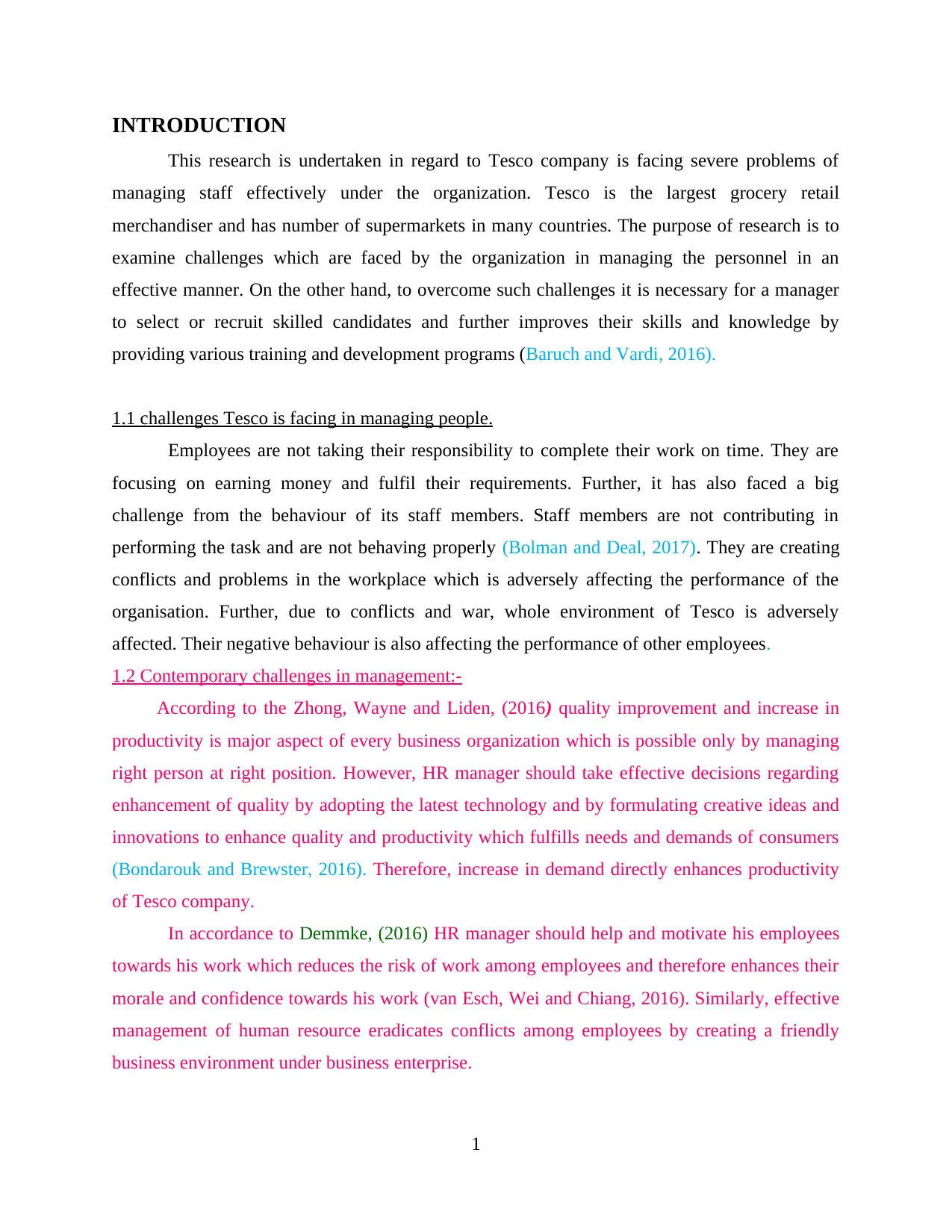
INTRODUCTION
This research is undertaken in regard to Tesco company is facing severe problems of
managing staff effectively under the organization. Tesco is the largest grocery retail
merchandiser and has number of supermarkets in many countries. The purpose of research is to
examine challenges which are faced by the organization in managing the personnel in an
effective manner. On the other hand, to overcome such challenges it is necessary for a manager
to select or recruit skilled candidates and further improves their skills and knowledge by
providing various training and development programs (Baruch and Vardi, 2016).
1.1 challenges Tesco is facing in managing people.
Employees are not taking their responsibility to complete their work on time. They are
focusing on earning money and fulfil their requirements. Further, it has also faced a big
challenge from the behaviour of its staff members. Staff members are not contributing in
performing the task and are not behaving properly (Bolman and Deal, 2017). They are creating
conflicts and problems in the workplace which is adversely affecting the performance of the
organisation. Further, due to conflicts and war, whole environment of Tesco is adversely
affected. Their negative behaviour is also affecting the performance of other employees.
1.2 Contemporary challenges in management:-
According to the Zhong, Wayne and Liden, (2016) quality improvement and increase in
productivity is major aspect of every business organization which is possible only by managing
right person at right position. However, HR manager should take effective decisions regarding
enhancement of quality by adopting the latest technology and by formulating creative ideas and
innovations to enhance quality and productivity which fulfills needs and demands of consumers
(Bondarouk and Brewster, 2016). Therefore, increase in demand directly enhances productivity
of Tesco company.
In accordance to Demmke, (2016) HR manager should help and motivate his employees
towards his work which reduces the risk of work among employees and therefore enhances their
morale and confidence towards his work (van Esch, Wei and Chiang, 2016). Similarly, effective
management of human resource eradicates conflicts among employees by creating a friendly
business environment under business enterprise.
1
This research is undertaken in regard to Tesco company is facing severe problems of
managing staff effectively under the organization. Tesco is the largest grocery retail
merchandiser and has number of supermarkets in many countries. The purpose of research is to
examine challenges which are faced by the organization in managing the personnel in an
effective manner. On the other hand, to overcome such challenges it is necessary for a manager
to select or recruit skilled candidates and further improves their skills and knowledge by
providing various training and development programs (Baruch and Vardi, 2016).
1.1 challenges Tesco is facing in managing people.
Employees are not taking their responsibility to complete their work on time. They are
focusing on earning money and fulfil their requirements. Further, it has also faced a big
challenge from the behaviour of its staff members. Staff members are not contributing in
performing the task and are not behaving properly (Bolman and Deal, 2017). They are creating
conflicts and problems in the workplace which is adversely affecting the performance of the
organisation. Further, due to conflicts and war, whole environment of Tesco is adversely
affected. Their negative behaviour is also affecting the performance of other employees.
1.2 Contemporary challenges in management:-
According to the Zhong, Wayne and Liden, (2016) quality improvement and increase in
productivity is major aspect of every business organization which is possible only by managing
right person at right position. However, HR manager should take effective decisions regarding
enhancement of quality by adopting the latest technology and by formulating creative ideas and
innovations to enhance quality and productivity which fulfills needs and demands of consumers
(Bondarouk and Brewster, 2016). Therefore, increase in demand directly enhances productivity
of Tesco company.
In accordance to Demmke, (2016) HR manager should help and motivate his employees
towards his work which reduces the risk of work among employees and therefore enhances their
morale and confidence towards his work (van Esch, Wei and Chiang, 2016). Similarly, effective
management of human resource eradicates conflicts among employees by creating a friendly
business environment under business enterprise.
1
⊘ This is a preview!⊘
Do you want full access?
Subscribe today to unlock all pages.

Trusted by 1+ million students worldwide
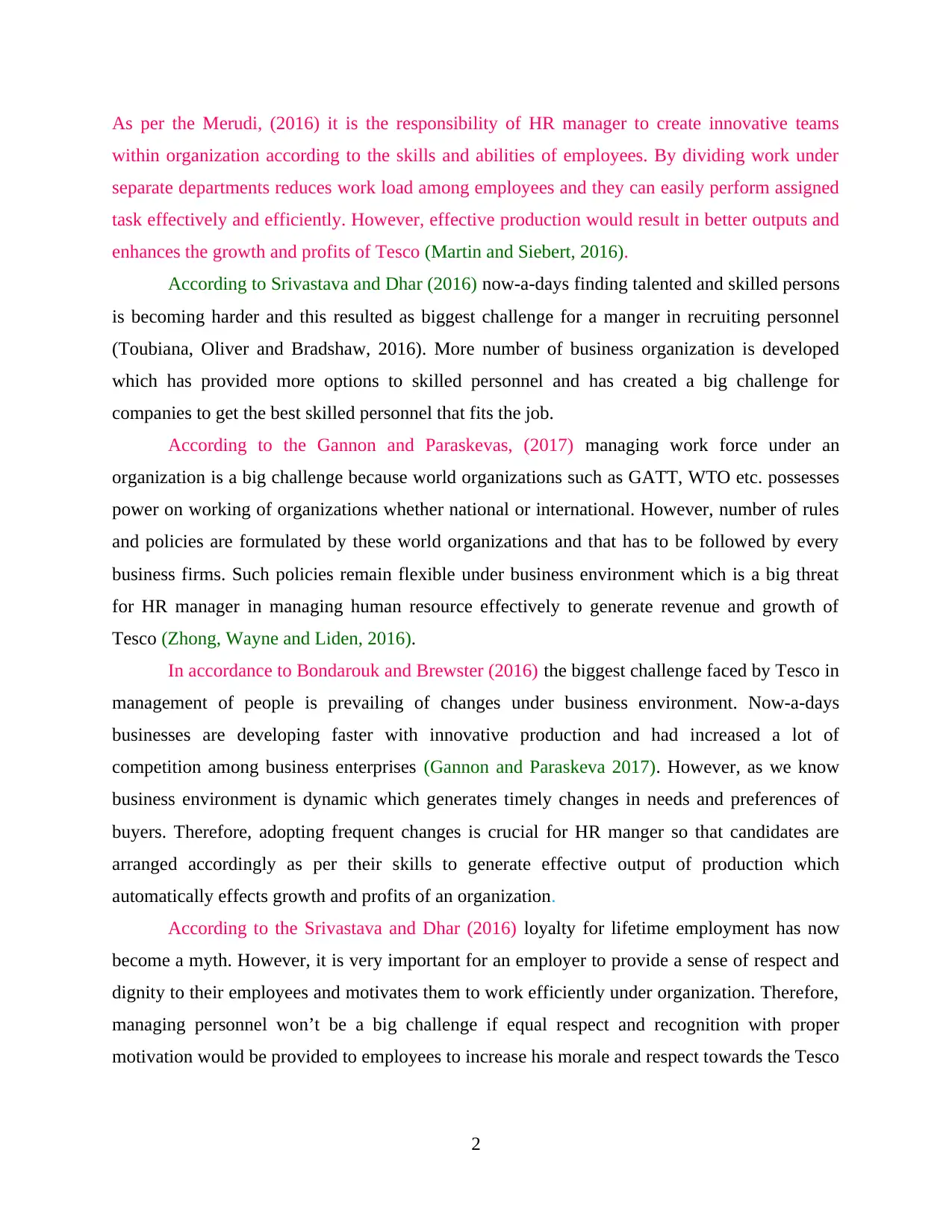
As per the Merudi, (2016) it is the responsibility of HR manager to create innovative teams
within organization according to the skills and abilities of employees. By dividing work under
separate departments reduces work load among employees and they can easily perform assigned
task effectively and efficiently. However, effective production would result in better outputs and
enhances the growth and profits of Tesco (Martin and Siebert, 2016).
According to Srivastava and Dhar (2016) now-a-days finding talented and skilled persons
is becoming harder and this resulted as biggest challenge for a manger in recruiting personnel
(Toubiana, Oliver and Bradshaw, 2016). More number of business organization is developed
which has provided more options to skilled personnel and has created a big challenge for
companies to get the best skilled personnel that fits the job.
According to the Gannon and Paraskevas, (2017) managing work force under an
organization is a big challenge because world organizations such as GATT, WTO etc. possesses
power on working of organizations whether national or international. However, number of rules
and policies are formulated by these world organizations and that has to be followed by every
business firms. Such policies remain flexible under business environment which is a big threat
for HR manager in managing human resource effectively to generate revenue and growth of
Tesco (Zhong, Wayne and Liden, 2016).
In accordance to Bondarouk and Brewster (2016) the biggest challenge faced by Tesco in
management of people is prevailing of changes under business environment. Now-a-days
businesses are developing faster with innovative production and had increased a lot of
competition among business enterprises (Gannon and Paraskeva 2017). However, as we know
business environment is dynamic which generates timely changes in needs and preferences of
buyers. Therefore, adopting frequent changes is crucial for HR manger so that candidates are
arranged accordingly as per their skills to generate effective output of production which
automatically effects growth and profits of an organization.
According to the Srivastava and Dhar (2016) loyalty for lifetime employment has now
become a myth. However, it is very important for an employer to provide a sense of respect and
dignity to their employees and motivates them to work efficiently under organization. Therefore,
managing personnel won’t be a big challenge if equal respect and recognition with proper
motivation would be provided to employees to increase his morale and respect towards the Tesco
2
within organization according to the skills and abilities of employees. By dividing work under
separate departments reduces work load among employees and they can easily perform assigned
task effectively and efficiently. However, effective production would result in better outputs and
enhances the growth and profits of Tesco (Martin and Siebert, 2016).
According to Srivastava and Dhar (2016) now-a-days finding talented and skilled persons
is becoming harder and this resulted as biggest challenge for a manger in recruiting personnel
(Toubiana, Oliver and Bradshaw, 2016). More number of business organization is developed
which has provided more options to skilled personnel and has created a big challenge for
companies to get the best skilled personnel that fits the job.
According to the Gannon and Paraskevas, (2017) managing work force under an
organization is a big challenge because world organizations such as GATT, WTO etc. possesses
power on working of organizations whether national or international. However, number of rules
and policies are formulated by these world organizations and that has to be followed by every
business firms. Such policies remain flexible under business environment which is a big threat
for HR manager in managing human resource effectively to generate revenue and growth of
Tesco (Zhong, Wayne and Liden, 2016).
In accordance to Bondarouk and Brewster (2016) the biggest challenge faced by Tesco in
management of people is prevailing of changes under business environment. Now-a-days
businesses are developing faster with innovative production and had increased a lot of
competition among business enterprises (Gannon and Paraskeva 2017). However, as we know
business environment is dynamic which generates timely changes in needs and preferences of
buyers. Therefore, adopting frequent changes is crucial for HR manger so that candidates are
arranged accordingly as per their skills to generate effective output of production which
automatically effects growth and profits of an organization.
According to the Srivastava and Dhar (2016) loyalty for lifetime employment has now
become a myth. However, it is very important for an employer to provide a sense of respect and
dignity to their employees and motivates them to work efficiently under organization. Therefore,
managing personnel won’t be a big challenge if equal respect and recognition with proper
motivation would be provided to employees to increase his morale and respect towards the Tesco
2
Paraphrase This Document
Need a fresh take? Get an instant paraphrase of this document with our AI Paraphraser
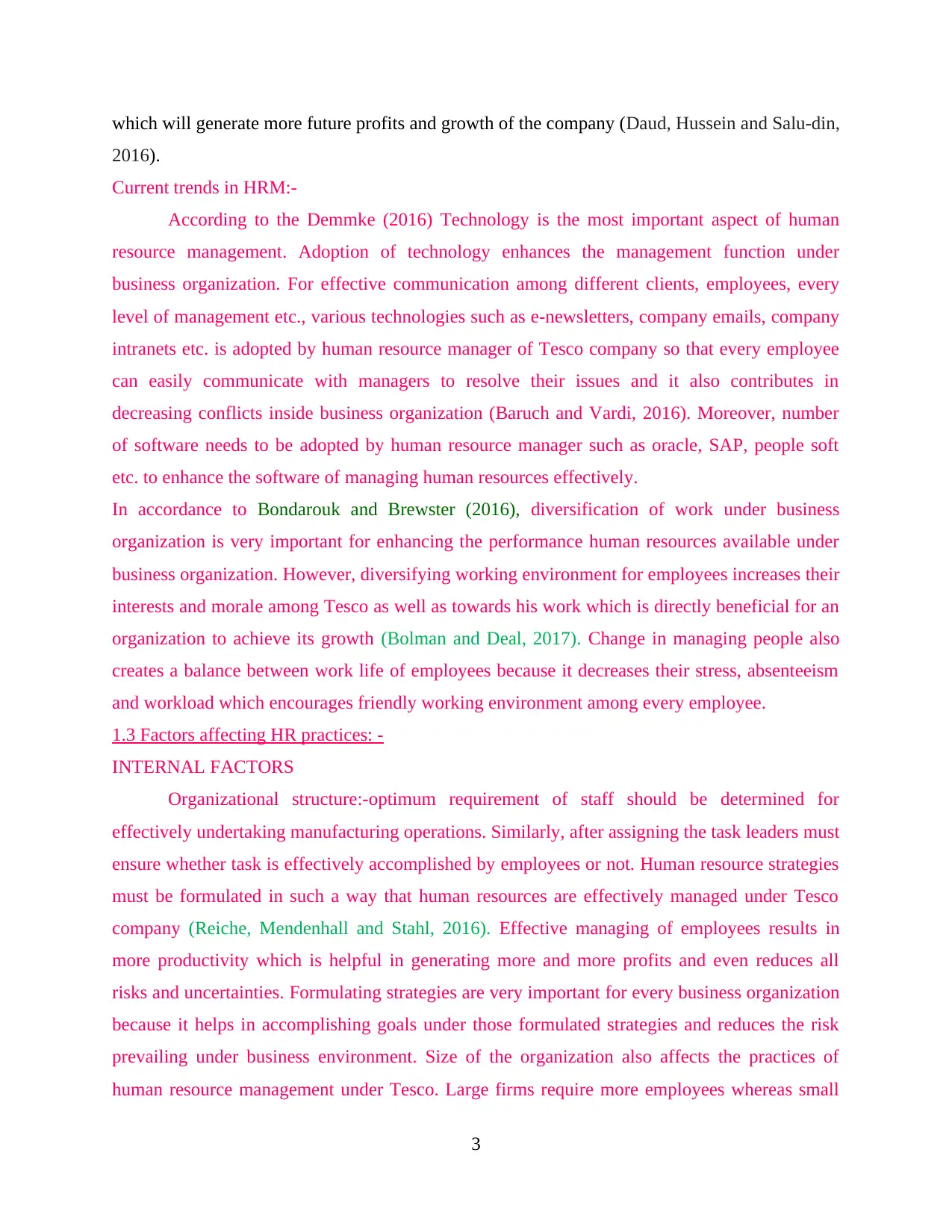
which will generate more future profits and growth of the company (Daud, Hussein and Salu-din,
2016).
Current trends in HRM:-
According to the Demmke (2016) Technology is the most important aspect of human
resource management. Adoption of technology enhances the management function under
business organization. For effective communication among different clients, employees, every
level of management etc., various technologies such as e-newsletters, company emails, company
intranets etc. is adopted by human resource manager of Tesco company so that every employee
can easily communicate with managers to resolve their issues and it also contributes in
decreasing conflicts inside business organization (Baruch and Vardi, 2016). Moreover, number
of software needs to be adopted by human resource manager such as oracle, SAP, people soft
etc. to enhance the software of managing human resources effectively.
In accordance to Bondarouk and Brewster (2016), diversification of work under business
organization is very important for enhancing the performance human resources available under
business organization. However, diversifying working environment for employees increases their
interests and morale among Tesco as well as towards his work which is directly beneficial for an
organization to achieve its growth (Bolman and Deal, 2017). Change in managing people also
creates a balance between work life of employees because it decreases their stress, absenteeism
and workload which encourages friendly working environment among every employee.
1.3 Factors affecting HR practices: -
INTERNAL FACTORS
Organizational structure:-optimum requirement of staff should be determined for
effectively undertaking manufacturing operations. Similarly, after assigning the task leaders must
ensure whether task is effectively accomplished by employees or not. Human resource strategies
must be formulated in such a way that human resources are effectively managed under Tesco
company (Reiche, Mendenhall and Stahl, 2016). Effective managing of employees results in
more productivity which is helpful in generating more and more profits and even reduces all
risks and uncertainties. Formulating strategies are very important for every business organization
because it helps in accomplishing goals under those formulated strategies and reduces the risk
prevailing under business environment. Size of the organization also affects the practices of
human resource management under Tesco. Large firms require more employees whereas small
3
2016).
Current trends in HRM:-
According to the Demmke (2016) Technology is the most important aspect of human
resource management. Adoption of technology enhances the management function under
business organization. For effective communication among different clients, employees, every
level of management etc., various technologies such as e-newsletters, company emails, company
intranets etc. is adopted by human resource manager of Tesco company so that every employee
can easily communicate with managers to resolve their issues and it also contributes in
decreasing conflicts inside business organization (Baruch and Vardi, 2016). Moreover, number
of software needs to be adopted by human resource manager such as oracle, SAP, people soft
etc. to enhance the software of managing human resources effectively.
In accordance to Bondarouk and Brewster (2016), diversification of work under business
organization is very important for enhancing the performance human resources available under
business organization. However, diversifying working environment for employees increases their
interests and morale among Tesco as well as towards his work which is directly beneficial for an
organization to achieve its growth (Bolman and Deal, 2017). Change in managing people also
creates a balance between work life of employees because it decreases their stress, absenteeism
and workload which encourages friendly working environment among every employee.
1.3 Factors affecting HR practices: -
INTERNAL FACTORS
Organizational structure:-optimum requirement of staff should be determined for
effectively undertaking manufacturing operations. Similarly, after assigning the task leaders must
ensure whether task is effectively accomplished by employees or not. Human resource strategies
must be formulated in such a way that human resources are effectively managed under Tesco
company (Reiche, Mendenhall and Stahl, 2016). Effective managing of employees results in
more productivity which is helpful in generating more and more profits and even reduces all
risks and uncertainties. Formulating strategies are very important for every business organization
because it helps in accomplishing goals under those formulated strategies and reduces the risk
prevailing under business environment. Size of the organization also affects the practices of
human resource management under Tesco. Large firms require more employees whereas small
3
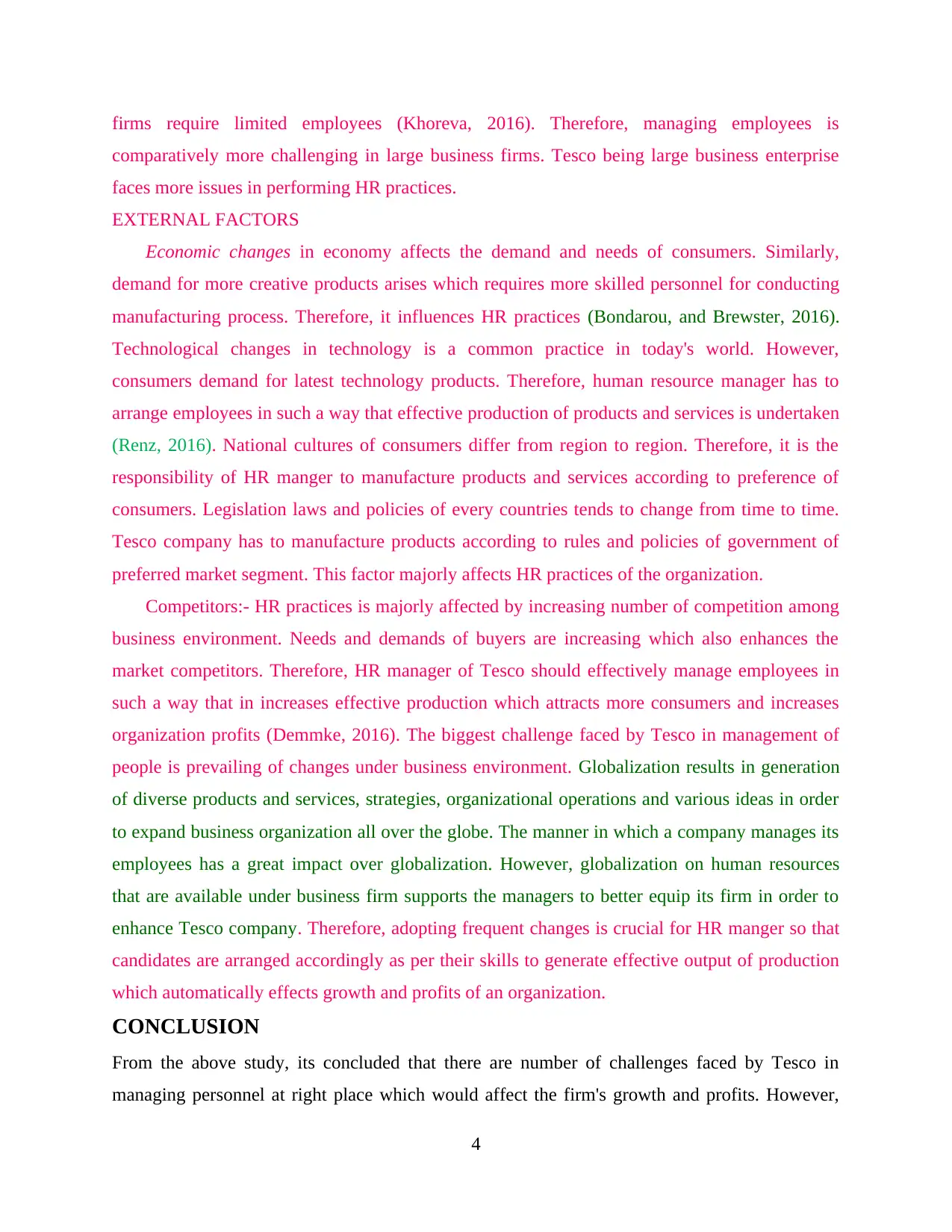
firms require limited employees (Khoreva, 2016). Therefore, managing employees is
comparatively more challenging in large business firms. Tesco being large business enterprise
faces more issues in performing HR practices.
EXTERNAL FACTORS
Economic changes in economy affects the demand and needs of consumers. Similarly,
demand for more creative products arises which requires more skilled personnel for conducting
manufacturing process. Therefore, it influences HR practices (Bondarou, and Brewster, 2016).
Technological changes in technology is a common practice in today's world. However,
consumers demand for latest technology products. Therefore, human resource manager has to
arrange employees in such a way that effective production of products and services is undertaken
(Renz, 2016). National cultures of consumers differ from region to region. Therefore, it is the
responsibility of HR manger to manufacture products and services according to preference of
consumers. Legislation laws and policies of every countries tends to change from time to time.
Tesco company has to manufacture products according to rules and policies of government of
preferred market segment. This factor majorly affects HR practices of the organization.
Competitors:- HR practices is majorly affected by increasing number of competition among
business environment. Needs and demands of buyers are increasing which also enhances the
market competitors. Therefore, HR manager of Tesco should effectively manage employees in
such a way that in increases effective production which attracts more consumers and increases
organization profits (Demmke, 2016). The biggest challenge faced by Tesco in management of
people is prevailing of changes under business environment. Globalization results in generation
of diverse products and services, strategies, organizational operations and various ideas in order
to expand business organization all over the globe. The manner in which a company manages its
employees has a great impact over globalization. However, globalization on human resources
that are available under business firm supports the managers to better equip its firm in order to
enhance Tesco company. Therefore, adopting frequent changes is crucial for HR manger so that
candidates are arranged accordingly as per their skills to generate effective output of production
which automatically effects growth and profits of an organization.
CONCLUSION
From the above study, its concluded that there are number of challenges faced by Tesco in
managing personnel at right place which would affect the firm's growth and profits. However,
4
comparatively more challenging in large business firms. Tesco being large business enterprise
faces more issues in performing HR practices.
EXTERNAL FACTORS
Economic changes in economy affects the demand and needs of consumers. Similarly,
demand for more creative products arises which requires more skilled personnel for conducting
manufacturing process. Therefore, it influences HR practices (Bondarou, and Brewster, 2016).
Technological changes in technology is a common practice in today's world. However,
consumers demand for latest technology products. Therefore, human resource manager has to
arrange employees in such a way that effective production of products and services is undertaken
(Renz, 2016). National cultures of consumers differ from region to region. Therefore, it is the
responsibility of HR manger to manufacture products and services according to preference of
consumers. Legislation laws and policies of every countries tends to change from time to time.
Tesco company has to manufacture products according to rules and policies of government of
preferred market segment. This factor majorly affects HR practices of the organization.
Competitors:- HR practices is majorly affected by increasing number of competition among
business environment. Needs and demands of buyers are increasing which also enhances the
market competitors. Therefore, HR manager of Tesco should effectively manage employees in
such a way that in increases effective production which attracts more consumers and increases
organization profits (Demmke, 2016). The biggest challenge faced by Tesco in management of
people is prevailing of changes under business environment. Globalization results in generation
of diverse products and services, strategies, organizational operations and various ideas in order
to expand business organization all over the globe. The manner in which a company manages its
employees has a great impact over globalization. However, globalization on human resources
that are available under business firm supports the managers to better equip its firm in order to
enhance Tesco company. Therefore, adopting frequent changes is crucial for HR manger so that
candidates are arranged accordingly as per their skills to generate effective output of production
which automatically effects growth and profits of an organization.
CONCLUSION
From the above study, its concluded that there are number of challenges faced by Tesco in
managing personnel at right place which would affect the firm's growth and profits. However,
4
⊘ This is a preview!⊘
Do you want full access?
Subscribe today to unlock all pages.

Trusted by 1+ million students worldwide
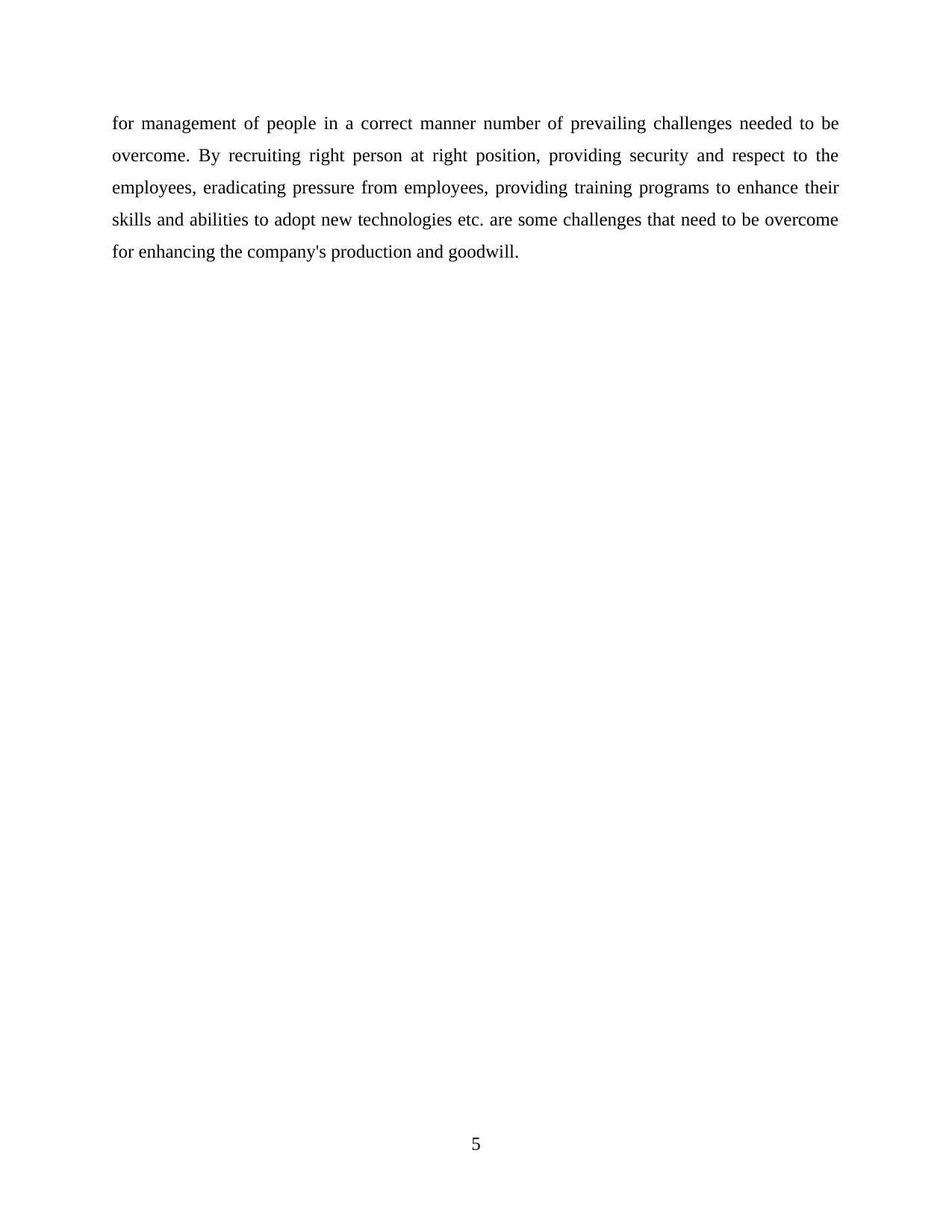
for management of people in a correct manner number of prevailing challenges needed to be
overcome. By recruiting right person at right position, providing security and respect to the
employees, eradicating pressure from employees, providing training programs to enhance their
skills and abilities to adopt new technologies etc. are some challenges that need to be overcome
for enhancing the company's production and goodwill.
5
overcome. By recruiting right person at right position, providing security and respect to the
employees, eradicating pressure from employees, providing training programs to enhance their
skills and abilities to adopt new technologies etc. are some challenges that need to be overcome
for enhancing the company's production and goodwill.
5
Paraphrase This Document
Need a fresh take? Get an instant paraphrase of this document with our AI Paraphraser
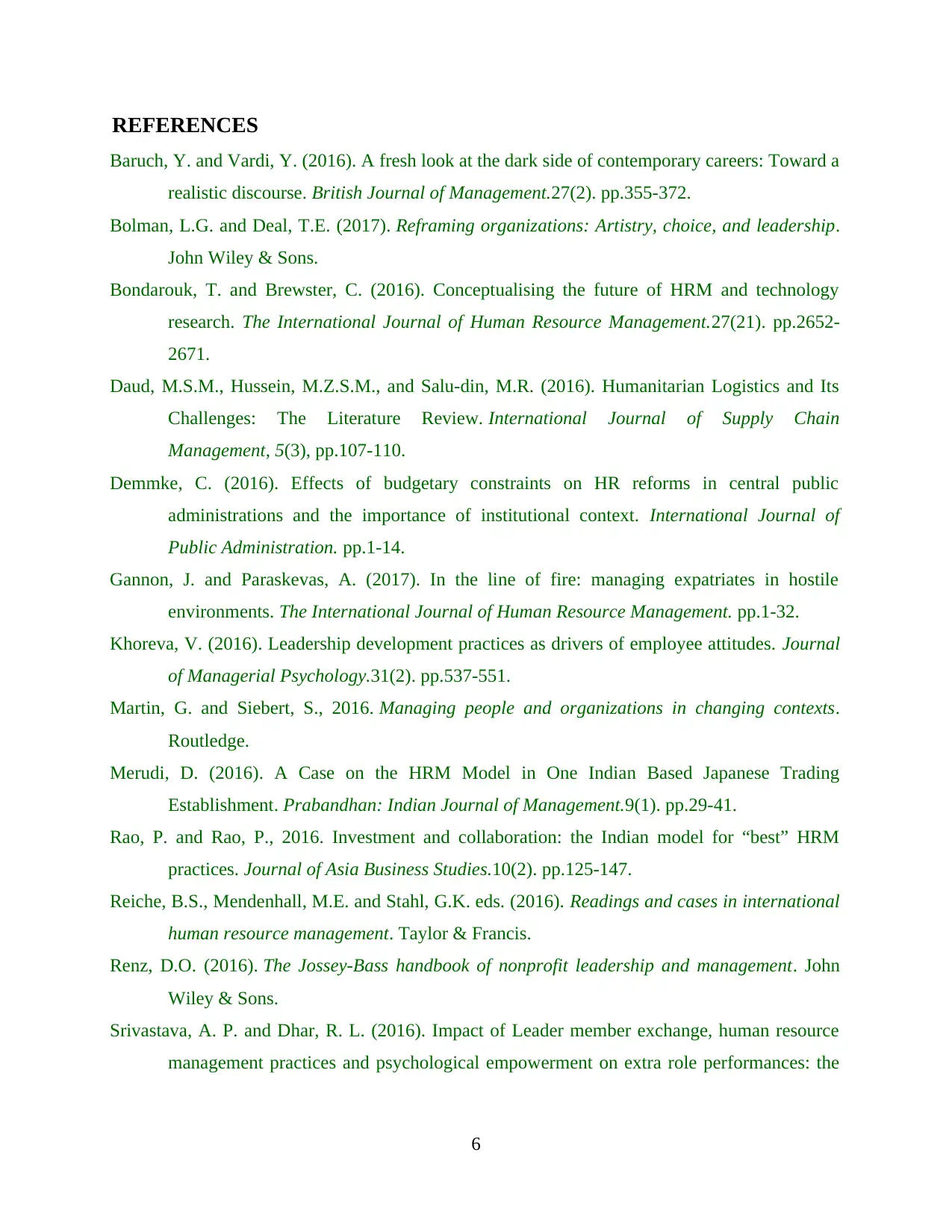
REFERENCES
Baruch, Y. and Vardi, Y. (2016). A fresh look at the dark side of contemporary careers: Toward a
realistic discourse. British Journal of Management.27(2). pp.355-372.
Bolman, L.G. and Deal, T.E. (2017). Reframing organizations: Artistry, choice, and leadership.
John Wiley & Sons.
Bondarouk, T. and Brewster, C. (2016). Conceptualising the future of HRM and technology
research. The International Journal of Human Resource Management.27(21). pp.2652-
2671.
Daud, M.S.M., Hussein, M.Z.S.M., and Salu-din, M.R. (2016). Humanitarian Logistics and Its
Challenges: The Literature Review. International Journal of Supply Chain
Management, 5(3), pp.107-110.
Demmke, C. (2016). Effects of budgetary constraints on HR reforms in central public
administrations and the importance of institutional context. International Journal of
Public Administration. pp.1-14.
Gannon, J. and Paraskevas, A. (2017). In the line of fire: managing expatriates in hostile
environments. The International Journal of Human Resource Management. pp.1-32.
Khoreva, V. (2016). Leadership development practices as drivers of employee attitudes. Journal
of Managerial Psychology.31(2). pp.537-551.
Martin, G. and Siebert, S., 2016. Managing people and organizations in changing contexts.
Routledge.
Merudi, D. (2016). A Case on the HRM Model in One Indian Based Japanese Trading
Establishment. Prabandhan: Indian Journal of Management.9(1). pp.29-41.
Rao, P. and Rao, P., 2016. Investment and collaboration: the Indian model for “best” HRM
practices. Journal of Asia Business Studies.10(2). pp.125-147.
Reiche, B.S., Mendenhall, M.E. and Stahl, G.K. eds. (2016). Readings and cases in international
human resource management. Taylor & Francis.
Renz, D.O. (2016). The Jossey-Bass handbook of nonprofit leadership and management. John
Wiley & Sons.
Srivastava, A. P. and Dhar, R. L. (2016). Impact of Leader member exchange, human resource
management practices and psychological empowerment on extra role performances: the
6
Baruch, Y. and Vardi, Y. (2016). A fresh look at the dark side of contemporary careers: Toward a
realistic discourse. British Journal of Management.27(2). pp.355-372.
Bolman, L.G. and Deal, T.E. (2017). Reframing organizations: Artistry, choice, and leadership.
John Wiley & Sons.
Bondarouk, T. and Brewster, C. (2016). Conceptualising the future of HRM and technology
research. The International Journal of Human Resource Management.27(21). pp.2652-
2671.
Daud, M.S.M., Hussein, M.Z.S.M., and Salu-din, M.R. (2016). Humanitarian Logistics and Its
Challenges: The Literature Review. International Journal of Supply Chain
Management, 5(3), pp.107-110.
Demmke, C. (2016). Effects of budgetary constraints on HR reforms in central public
administrations and the importance of institutional context. International Journal of
Public Administration. pp.1-14.
Gannon, J. and Paraskevas, A. (2017). In the line of fire: managing expatriates in hostile
environments. The International Journal of Human Resource Management. pp.1-32.
Khoreva, V. (2016). Leadership development practices as drivers of employee attitudes. Journal
of Managerial Psychology.31(2). pp.537-551.
Martin, G. and Siebert, S., 2016. Managing people and organizations in changing contexts.
Routledge.
Merudi, D. (2016). A Case on the HRM Model in One Indian Based Japanese Trading
Establishment. Prabandhan: Indian Journal of Management.9(1). pp.29-41.
Rao, P. and Rao, P., 2016. Investment and collaboration: the Indian model for “best” HRM
practices. Journal of Asia Business Studies.10(2). pp.125-147.
Reiche, B.S., Mendenhall, M.E. and Stahl, G.K. eds. (2016). Readings and cases in international
human resource management. Taylor & Francis.
Renz, D.O. (2016). The Jossey-Bass handbook of nonprofit leadership and management. John
Wiley & Sons.
Srivastava, A. P. and Dhar, R. L. (2016). Impact of Leader member exchange, human resource
management practices and psychological empowerment on extra role performances: the
6
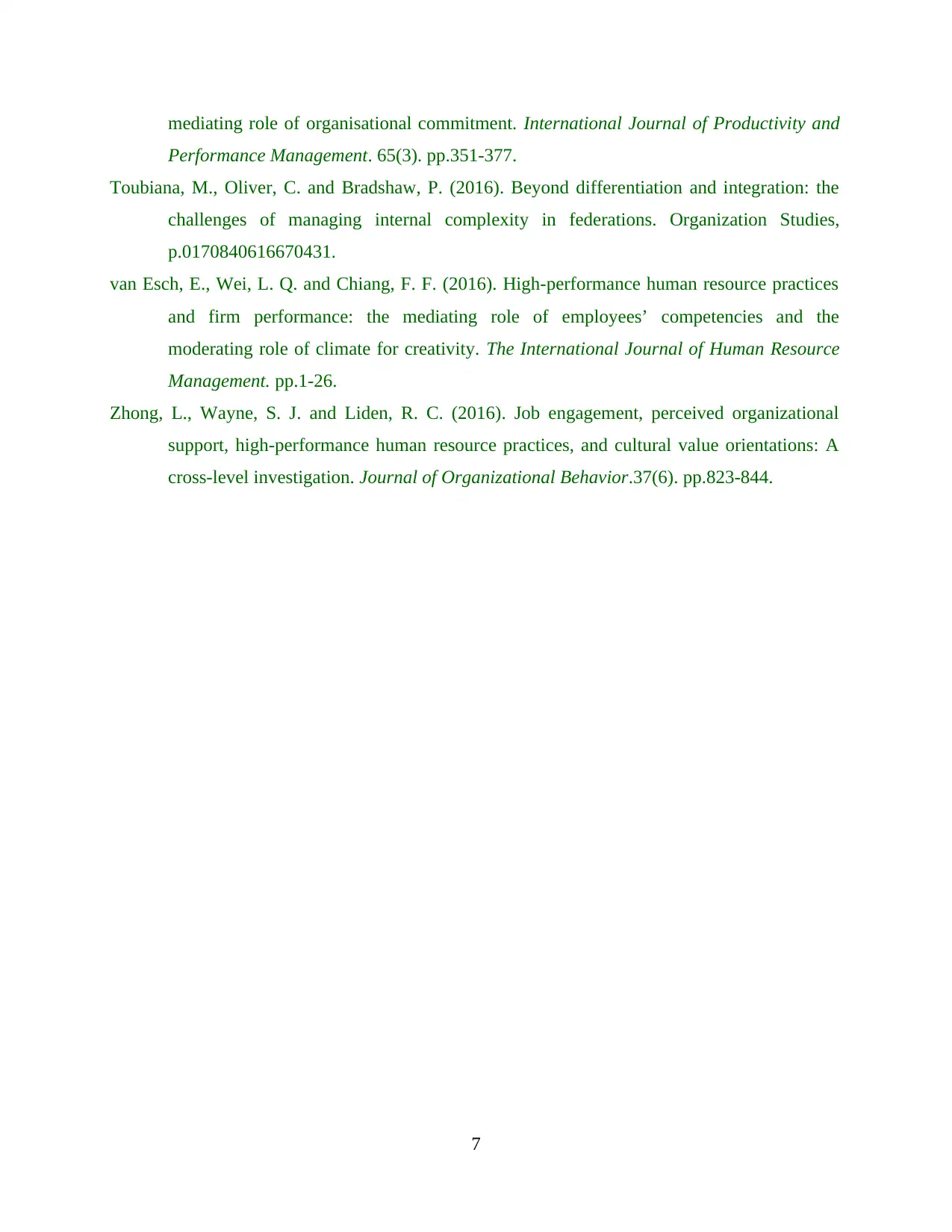
mediating role of organisational commitment. International Journal of Productivity and
Performance Management. 65(3). pp.351-377.
Toubiana, M., Oliver, C. and Bradshaw, P. (2016). Beyond differentiation and integration: the
challenges of managing internal complexity in federations. Organization Studies,
p.0170840616670431.
van Esch, E., Wei, L. Q. and Chiang, F. F. (2016). High-performance human resource practices
and firm performance: the mediating role of employees’ competencies and the
moderating role of climate for creativity. The International Journal of Human Resource
Management. pp.1-26.
Zhong, L., Wayne, S. J. and Liden, R. C. (2016). Job engagement, perceived organizational
support, high‐performance human resource practices, and cultural value orientations: A
cross‐level investigation. Journal of Organizational Behavior.37(6). pp.823-844.
7
Performance Management. 65(3). pp.351-377.
Toubiana, M., Oliver, C. and Bradshaw, P. (2016). Beyond differentiation and integration: the
challenges of managing internal complexity in federations. Organization Studies,
p.0170840616670431.
van Esch, E., Wei, L. Q. and Chiang, F. F. (2016). High-performance human resource practices
and firm performance: the mediating role of employees’ competencies and the
moderating role of climate for creativity. The International Journal of Human Resource
Management. pp.1-26.
Zhong, L., Wayne, S. J. and Liden, R. C. (2016). Job engagement, perceived organizational
support, high‐performance human resource practices, and cultural value orientations: A
cross‐level investigation. Journal of Organizational Behavior.37(6). pp.823-844.
7
⊘ This is a preview!⊘
Do you want full access?
Subscribe today to unlock all pages.

Trusted by 1+ million students worldwide
1 out of 9
Related Documents
Your All-in-One AI-Powered Toolkit for Academic Success.
+13062052269
info@desklib.com
Available 24*7 on WhatsApp / Email
![[object Object]](/_next/static/media/star-bottom.7253800d.svg)
Unlock your academic potential
Copyright © 2020–2025 A2Z Services. All Rights Reserved. Developed and managed by ZUCOL.





